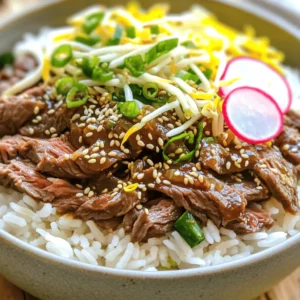Savor the mouthwatering flavors of Korean BBQ Beef Bowls with Sesame Sprouts! This easy recipe features tender marinated beef, fluffy jasmine rice, and crunchy bean sprouts for a delicious meal you can whip up in just 40 minutes. Perfect for dinner or meal prep, these bowls are customizable with your favorite toppings. Click to explore this simple and satisfying recipe that will impress your family and friends!
1 lb (450g) thinly sliced beef (sirloin or ribeye recommended)
¼ cup soy sauce
2 tablespoons brown sugar
1 tablespoon sesame oil
3 cloves garlic, finely minced
1 teaspoon fresh ginger, grated
1 tablespoon rice vinegar
2 cups cooked jasmine rice
1 cup fresh bean sprouts
½ cup scallions, chopped (green parts only)
1 tablespoon sesame seeds
1 teaspoon gochujang (Korean chili paste) – optional for added heat
Salt and freshly ground pepper to taste
Sliced radishes, for garnish
